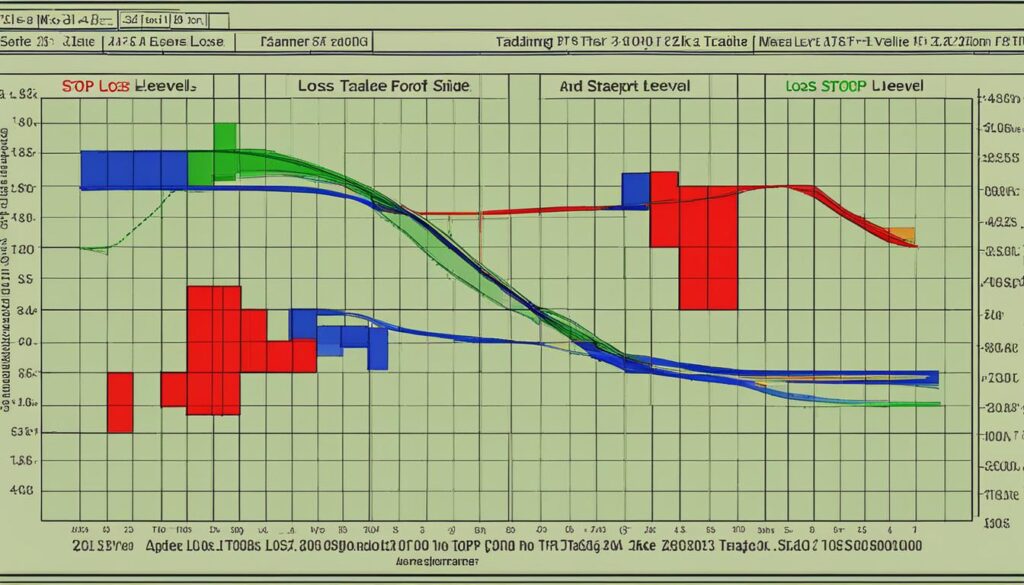Welcome to my beginner’s guide to decoding forex currency pairs. If you’re new to forex trading, understanding currency pairs is essential for successful trading. In this guide, I will explain the basics of forex signals and introduce some common trading indicators that can help you analyze currency pairs and make informed trading decisions.
Forex currency pairs represent the exchange rate between two currencies. For example, the EUR/USD pair represents the value of the Euro against the US Dollar. By analyzing these currency pairs, you can identify trends and predict future price movements.
Forex signals play a crucial role in decoding currency pairs. These signals provide insights into the market conditions and potential trading opportunities. They can be generated by various trading indicators, which act as tools for analyzing and interpreting market data.
Through this guide, you will learn about popular trading indicators such as moving averages, Relative Strength Index (RSI), Bollinger Bands, and MACD. These indicators can help you identify trends, determine entry and exit points, and manage risk effectively.
Key Takeaways:
- Understanding currency pairs is essential for forex trading.
- Forex signals provide insights into market conditions and trading opportunities.
- Trading indicators like moving averages, RSI, Bollinger Bands, and MACD can help analyze currency pairs.
- Decoding forex signals is crucial for making informed trading decisions.
- Stay tuned for the upcoming sections where we will delve deeper into forex signals and how to utilize them in your trading strategy.
Understanding Forex Signals and Trading Indicators
When it comes to forex trading, understanding forex signals and using trading indicators is crucial for making informed decisions. Forex signals are indicators or suggestions that signify favorable trading opportunities. These signals are generated by various trading indicators, such as moving averages, the Relative Strength Index (RSI), Bollinger Bands, and the Moving Average Convergence Divergence (MACD).
Moving averages are one of the most commonly used indicators in forex trading. They help smooth out price fluctuations and identify trends by calculating the average price over a specific period. Traders often use moving averages to determine entry and exit points and to confirm trend changes.
The Relative Strength Index (RSI) is a momentum indicator that measures the speed and change of price movements. It oscillates between 0 and 100, with values above 70 indicating overbought conditions and values below 30 indicating oversold conditions. Traders use the RSI to identify potential reversal points and assess the strength of a trend.
Bollinger Bands consist of a central moving average line and two outer bands that represent standard deviations from the moving average. These bands dynamically adjust based on market volatility. Traders use Bollinger Bands to identify overbought and oversold conditions, as well as potential breakout opportunities.
The Moving Average Convergence Divergence (MACD) is a trend-following momentum indicator that calculates the difference between two moving averages and plots it as a line. It is often accompanied by a histogram that represents the difference between the MACD line and its signal line. Traders use the MACD to identify trend reversals, confirm trading signals, and spot potential buy or sell opportunities.
By understanding these indicators and the signals they generate, forex traders can gain valuable insights into market trends, identify potential entry and exit points, and make informed trading decisions. Utilizing a combination of these indicators can provide a comprehensive analysis of currency pairs and increase the probability of successful trades.
| Indicator | Description |
|---|---|
| Moving Averages | Calculates the average price over a specific period to identify trends and determine entry/exit points. |
| Relative Strength Index (RSI) | Momentum indicator that measures the speed and change of price movements to assess trend strength and identify reversal points. |
| Bollinger Bands | Consists of a central moving average line and two outer bands that represent standard deviations from the moving average. Helps identify overbought and oversold conditions. |
| Moving Average Convergence Divergence (MACD) | Trend-following indicator that calculates the difference between two moving averages and helps identify trend reversals and potential buy/sell opportunities. |
Utilizing Forex Signals in Your Trading
When it comes to forex trading, effectively utilizing forex signals can significantly enhance your trading strategy and increase your chances of success. In this section, I will provide you with practical tips on how to make the most out of forex signals in your trading journey.
Trend Spotting
One key aspect of utilizing forex signals is trend spotting. By identifying and understanding market trends, you can position yourself to make profitable trades. Keep an eye out for patterns and indicators that indicate the direction of the market, such as moving averages or breakout levels.
Timing Entry and Exit
Timing is crucial in forex trading. It’s essential to enter and exit trades at the right moment to maximize your profits and minimize your losses. Forex signals can provide valuable insights into the optimal timing for executing your trades. Pay close attention to the signals and combine them with technical analysis to make well-timed trading decisions.
Volatility Awareness
Being aware of market volatility is important for managing your risk and maximizing your trading opportunities. Forex signals can help you gauge the level of volatility in the market and adjust your trading strategy accordingly. If the market is highly volatile, consider adjusting your position size or setting wider stop-loss and take-profit levels to account for potential market fluctuations.
Confirming Trends Using MACD
One widely-used trading indicator for confirming trends is the Moving Average Convergence Divergence (MACD). This indicator helps you identify potential trend reversals and confirm the strength of a trend. By combining the signals from MACD with other indicators, you can have a more comprehensive understanding of the market trend and make informed trading decisions.
Risk Management
Risk management is a vital aspect of successful forex trading. It’s crucial to implement risk management strategies to protect your capital and minimize potential losses. Consider setting stop-loss orders to limit your downside risk and take-profit levels to secure your gains. Additionally, diversify your portfolio and avoid risking too much on a single trade.
As you incorporate forex signals into your trading strategy, always prioritize risk management to ensure long-term profitability and sustainability.

Remember, utilizing forex signals requires a combination of technical analysis, market awareness, and risk management. By integrating these aspects into your trading approach, you can make the most out of forex signals and increase your chances of achieving consistent profitability.
Risk Management: Protecting Your Trading Capital
In the world of forex trading, risk management is a critical aspect that every trader must understand and implement effectively. By implementing proper risk management strategies, you can protect your capital and minimize potential losses. In this section, I will explain two essential components of risk management: stop-loss and take-profit levels, and position sizing.
Setting Stop-Loss and Take-Profit Levels
Setting stop-loss and take-profit levels is crucial to managing risk in forex trading. A stop-loss level is the price at which you are willing to exit a trade to limit potential losses. On the other hand, a take-profit level is the price at which you want to secure your gains and close a trade.
To determine the appropriate stop-loss and take-profit levels, you should consider various factors, such as market volatility, support and resistance levels, and your risk tolerance. Stop-loss and take-profit levels should be based on a logical assessment of market conditions and should not be randomly chosen.
By using stop-loss and take-profit orders, you can ensure that you have predefined exit points for your trades, even if you are not actively monitoring the market. These orders are executed automatically when the specified price levels are reached, reducing the potential for emotional decision-making and allowing you to stick to your trading plan.
Importance of Position Sizing
Position sizing refers to determining the appropriate amount of capital to risk on each trade based on your account size and risk tolerance. Proper position sizing is essential for managing risk and avoiding excessive losses.
When determining position sizing, you should consider the potential loss if the trade moves against you and set a maximum percentage of your trading capital that you are willing to risk on any single trade. This percentage, often referred to as the risk per trade, should align with your overall risk tolerance.
By effectively managing your position sizing, you can ensure that no single trade has the potential to significantly impact your overall trading capital. This approach allows you to spread your risk across multiple trades, increasing the likelihood of consistent profitability in the long run.
To summarize, setting stop-loss and take-profit levels and implementing proper position sizing are essential components of effective risk management in forex trading. These measures protect your trading capital and help you navigate the inherent uncertainties of the market. Now that we have covered risk management, let’s explore the constant learning curve in forex trading in the next section.
The Constant Learning Curve in Forex Trading
In the ever-evolving world of forex trading, continuous learning is essential. As a trader, staying curious and committed to expanding your knowledge will significantly contribute to your success in the market.
To stay ahead of the game, it’s crucial to explore new indicators and trading strategies. Keeping yourself updated with the latest developments in the industry allows you to adapt to changing market conditions and make informed trading decisions.
Demo trading is a valuable tool for continuous learning. It provides a risk-free training ground where you can practice executing trades, test different strategies, and gain hands-on experience without risking real capital. Utilize demo trading accounts offered by reputable brokers to hone your skills and explore new trading techniques.
One of the key qualities that separate successful traders from the rest is emotional resilience. The forex market can be unpredictable, and it’s important to remain calm and composed during periods of market turbulence. Developing emotional resilience allows you to make rational decisions based on analysis rather than being swayed by emotions such as fear or greed.
“Continuous learning is not only about acquiring new knowledge; it’s also about challenging your existing beliefs and gaining a deeper understanding of the market dynamics.”
By embracing continuous learning, demo trading, and nurturing emotional resilience, you can enhance your skills and improve your performance as a forex trader. Remember, the forex market is ever-changing, and adapting to new trends and developments is vital for long-term success.
Conclusion
As we wrap up our guide to forex currency pairs, it’s important to remember the key principles that will help you navigate the complex world of trading. Your forex trading journey will be filled with ups and downs, but by staying focused on your goals, you can achieve success.
One of the most critical factors in forex trading is adapting to market conditions. The financial markets are ever-changing, and it’s essential to adjust your strategies accordingly. By constantly analyzing and evaluating the market, you can identify trends and seize profitable opportunities.
However, even with the knowledge and market analysis, sticking to a game plan is crucial. It’s easy to get swayed by emotions or the fear of missing out, leading to impulsive decisions. By having a well-defined trading plan and disciplined approach, you can stay on track and make informed trading decisions.
In conclusion, forex trading is an exciting and dynamic endeavor that requires continuous learning and adaptation. By staying focused on your goals, adjusting to market conditions, and sticking to your game plan, you can navigate the forex market with confidence and increase your chances of success.
FAQ
What are forex currency pairs?
Forex currency pairs refer to the exchange rate between two different currencies in the foreign exchange market. They are used to determine the value of one currency in relation to another.
What are forex signals?
Forex signals are indicators or notifications generated by trading systems or professional traders that suggest potential entry and exit points for trading opportunities in the forex market.
How can forex signals benefit traders?
Forex signals can benefit traders by providing them with valuable insights and analysis of currency pairs, helping them make informed trading decisions. They can help traders spot trends, identify entry and exit points, and manage risk effectively.
What are common trading indicators used in forex analysis?
Common trading indicators used in forex analysis include moving averages, Relative Strength Index (RSI), Bollinger Bands, and Moving Average Convergence Divergence (MACD). These indicators help analyze currency pairs and predict future trends.
How can I effectively use forex signals in my trading strategy?
To effectively use forex signals in your trading strategy, you can follow practical tips such as trend spotting, timing entry and exit points, understanding volatility, confirming trends using MACD, and implementing risk management strategies.
What is the role of risk management in forex trading?
Risk management in forex trading is crucial as it helps protect your trading capital. It involves setting stop-loss and take-profit levels to limit potential losses and secure gains. Additionally, proper position sizing is important to manage risk effectively.
How can I continue learning in the world of forex trading?
Continuous learning is essential in forex trading. You can stay curious, explore new indicators, and stay updated on market trends. Demo trading can serve as a risk-free training ground, and emotional resilience is important in navigating market turbulence.
What are the key takeaways from this guide?
The key takeaways from this guide include the importance of staying focused on the big picture, adjusting to shifting market conditions, and sticking to your trading game plan throughout your forex trading journey.
Source Links
- https://fastercapital.com/content/Mastering-Currency-Pairs–Your-Guide-to-Forex-Success.html
- https://medium.com/@Boba99/decoding-forex-a-beginners-guide-to-currency-trading-from-a-spanish-trader-s-perspective-d55b499f0fbc
- https://www.tradingfxvps.com/decoding-forex-signals-a-beginners-guide-to-trading-indicators/
Disclaimer
All information on this website is of a general nature. The information is not adapted to conditions that are specific to your person or entity. The information provided can not be considered as personal, professional or legal advice or investment advice to the user.
This website and all information is intended for educational purposes only and does not give financial advice. Signal Mastermind Signals is not a service to provide legal and financial advice; any information provided here is only the personal opinion of the author (not advice or financial advice in any sense, and in the sense of any act, ordinance or law of any country) and must not be used for financial activities. Signal Mastermind Signals does not offer, operate or provide financial, brokerage, commercial or investment services and is not a financial advisor. Rather, Signal Mastermind Signals is an educational site and a platform for exchanging Forex information. Whenever information is disclosed, whether express or implied, about profit or revenue, it is not a guarantee. No method or trading system ensures that it will generate a profit, so always remember that trade can lead to a loss. Trading responsibility, whether resulting in profits or losses, is yours and you must agree not to hold Signal Mastermind Signals or other information providers that are responsible in any way whatsoever. The use of the system means that the user accepts Disclaimer and Terms of Use.
Signal Mastermind Signals is not represented as a registered investment consultant or brokerage dealer nor offers to buy or sell any of the financial instruments mentioned in the service offered.
While Signal Mastermind Signals believes that the content provided is accurate, there are no explicit or implied warranties of accuracy. The information provided is believed to be reliable; Signal Mastermind Signals does not guarantee the accuracy or completeness of the information provided. Third parties refer to Signal Mastermind Signals to provide technology and information if a third party fails, and then there is a risk that the information may be delayed or not delivered at all.
All information and comments contained on this website, including but not limited to, opinions, analyzes, news, prices, research, and general, do not constitute investment advice or an invitation to buy or sell any type of instrument. Signal Mastermind Signals assumes no responsibility for any loss or damage that may result, directly or indirectly, from the use or dependence on such information.
All information contained on this web site is a personal opinion or belief of the author. None of these data is a recommendation or financial advice in any sense, also within the meaning of any commercial act or law. Writers, publishers and affiliates of Signal Mastermind Signals are not responsible for your trading in any way.
The information and opinions contained in the site are provided for information only and for educational reasons, should never be considered as direct or indirect advice to open a trading account and / or invest money in Forex trading with any Forex company . Signal Mastermind Signals assumes no responsibility for any decisions taken by the user to create a merchant account with any of the brokers listed on this website. Anyone who decides to set up a trading account or use the services, free of charge or paid, to any of the Broker companies mentioned on this website, bears full responsibility for their actions.
Any institution that offers a service and is listed on this website, including forex brokers, financial companies and other institutions, is present only for informational purposes. All ratings, ratings, banners, reviews, or other information found for any of the above-mentioned institutions are provided in a strictly objective manner and according to the best possible reflection of the materials on the official website of the company.
Forex/CFD trading is potentially high risk and may not be suitable for all investors. The high level of leverage can work both for and against traders. Before each Forex/CFD investment, you should carefully consider your goals, past experience and risk level. The opinions and data contained on this site should not be considered as suggestions or advice for the sale or purchase of currency or other instruments. Past results do not show or guarantee future results.
Neither Signal Mastermind Signals nor its affiliates ensure the accuracy of the content provided on this Site. You explicitly agree that viewing, visiting or using this website is at your own risk.


